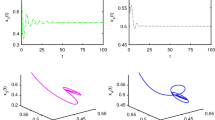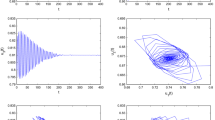Abstract
The delayed competitive web-site system with incommensurate fractional orders, based on the Lotka–Volterra competition model, is firstly proposed in this paper. It is demonstrated that there is a stability switch for time delay, Hopf bifurcation occurs when time delay crosses through a critical value and each order has important influence on the creation of bifurcation. Furthermore, a nonlinear delayed feedback control is successfully designed to postpone the onset of Hopf bifurcation, extend the stability domain, and then the system possesses the stability in a larger parameter range. Finally, numerical simulations are included to illustrate the efficiency of the obtained theoretical results.




Similar content being viewed by others
Explore related subjects
Discover the latest articles, news and stories from top researchers in related subjects.References
Strom D (1977) The best of push. Datamation 43(4):56–61
Adamic LA, Huberman BA (2000) The nature of markets in the world wide web. Q J Electron Commence 1:5–12
Maurer SM, Huberman BA (2003) Competitive dynamics of web sites. J Econ Dyn Control 27:2195–2206
Ren Y, Yang D, Diao X (2010) Websites competition model with market segmentation and its stability analysis. J Dalian Univ Technol 50(5):816–821
Cabo RM, Gimeno R (2013) Estimating population ecology models for the WWW market: evidence of competitive oligopolies. Nonlinear Dyn Psychol Life Sci 17(1):159–172
Aluja M, Ordano M, Guillen L, Rul J (2015) Understanding long-term fruit fly (Diptera: Tephritidae) population dynamics: implications for areawide management. J Econ Entomol 105(3):823–836
Li J, Zhao A (2015) Stability analysis of a non-autonomous Lotka–Volterra competition model with seasonal succession. Appl Math Model 40(2):763–781
Avelino PP, Bazeia D, Menezes J (2014) String networks in [formula omitted] Lotka–Volterra competition models. Phys Lett A 378(4):393–397
Jia Y, Wu J, Xu HK (2014) Positive solutions of a Lotka–Volterra competition model with cross-diffusion. Comput Math Appl 68(10):1220–1228
Caputo M (1967) Linear models of dissipation whose Q is almost frequency independent-II. Geophys J R Astron Soc 13:529–539
Kvitsinskii AA (1993) Fractional integrals and derivatives: theory and applications. Teoret Mat Fiz 3:397–414
Sun HH, Abdelwahab AA, Onaral B (1984) Linear approximation of transfer function with a pole of fractional order. IEEE Trans Autom Control 29:441–444
Podlubny I (1999) Fractional differential equations. Academic Press, New York
Mandelbrot BB (1982) The fractal geometry of nature. Henry Holt and Company, New York
Rakkiyappan R, Cao JD, Velmurugan G (2015) Existence and uniform stability analysis of fractional-order complex-valued neural networks with time delays. IEEE Trans Neural Netw Learn Syst 1(26):84–97
Liu H, Li S, Wang H, Huo Y, Luo J (2015) Adaptive synchronization for a class of uncertain fractional-order neural networks. Entropy 17(10):7185–7200
Li G, Liu H (2016) Stability analysis and synchronization for a class of fractional-order neural networks. Entropy 18(2):55
Xiao M, Zheng WX, Jiang GP, Cao JD (2015) Undamped oscillations generated by hopf bifurcations in fractional-order recurrent neural networks with caputo derivative. IEEE Trans Neural Netw Learn Syst 26(12):3201–3214
Cao JD, Xiao M (2007) Stability and Hopf bifurcation in a simplified BAM neural network with two time delays. IEEE Trans Neural Netw 18:416–430
Yu P (2004) Bifurcation dynamics in control systems. Bifurc Control 293(3):719–722
Abed EH, Fu JH (1987) Local feedback stabilization and bifurcation control: II. Stationary bifurcation. Syst Control Lett 8:467–473
Chen GR, Moiola JL, Wang HO (2000) Bifurcation control: theories, methods and applications. Int J Bifurc Chaos 10:511–548
Yu P, Chen G (2004) Hopf bifurcation control using nonlinear feedback with polynomial functions. Int J Bifurc Chaos 14:1683–1704
Pan Y, Yu H, Er MJ (2014) Adaptive neural pd control with semiglobal asymptotic stabilization guarantee. IEEE Trans Neural Netw Learn Syst 25(12):2264–2274
Pan Y, Liu Y, Xu B, Yu H (2016) Hybrid feedback feedforward: an efficient design of adaptive neural network control. Neural Netw 76:122–134
Pan Y, Yu H (2016) Composite learning from adaptive dynamic surface control. IEEE Trans Autom Control 61(9):2603–2609
Xiao M, Ho DWC, Cao JD (2009) Time-delayed feedback control of dynamical small-world networks at Hopf bifurcation. Nonlinear Dyn 58:319–344
Shi M, Wang ZH (2013) Stability and Hopf bifurcation control of a fractional-order small world network model. Sci China Phys Mech 43(4):467–477
Min X, Cao J (2006) Stability and Hopf bifurcation in a delayed competitive web sites model. Phys Lett A 353(2–3):138–150
Deng W, Li C, Lu J (2007) Stability analysis of linear fractional differential system with multiple time delays. Nonlinear Dyn 48(4):409–416
Zhang JL, Dou JH, Shi Y (2011) Hopf bifurcation of a competitive web-site system with reflexive and competition delays. Pure Appl Math 27:51–54
Xu CJ, Wu YS (2015) Frequency domain analysis for Hopf bifurcation in a delayed competitive web-site model. Int J Comput Inf Sci Engine 9(2):138–141
Huang CD, Cao JD, Xiao M (2016) Hybrid control on bifurcation for a delayed fractional gene regulatory network. Chaos Solitons Fract 87:19–29
Wang H, Yu Y, Wen G, Zhang S, Yu J (2015) Global stability analysis of fractional-order Hopfield neural networks with time delay. Neurocomputing 154(C):15–23
Abdelouahab MS, Hamri NE, Wang J (2012) Hopf bifurcation and chaos in fractional-order modified hybrid optical system. Nonlinear Dyn 69(1–2):275–284
Lozi RP, Abdelouahab MS (2015) Hopf Bifurcation and chaos in simplest fractional-order memristor-based electrical circuit. Indian J Ind Appl Math 6(2):105–119
Padula F, Alcantara S, Vilanova R, Visioli A (2013) \(H_\infty\)control of fractional linear systems. Automatica 49:2276–2280
Bhalekar S, Varsha D (2011) A predictor–corrector scheme for solving nonlinear delay differential equations of fractional order. J Fract Calc Appl 1(5):1–9
Acknowledgements
This work was jointly supported by the National Natural Science Foundation of China under Grant nos. 61573096, 61272530 and 61573194, the National Science Foundational of Jiangsu Province of China under Grant no. BK2012741, the “333 Engineering” Foundation of Jiangsu Province of China under Grant no. BRA2015286.
Author information
Authors and Affiliations
Corresponding author
Appendix
Appendix
1.1 Appendix A
1.2 Appendix B
Rights and permissions
About this article
Cite this article
Zhao, L., Cao, J., Huang, C. et al. Bifurcation control in the delayed fractional competitive web-site model with incommensurate-order. Int. J. Mach. Learn. & Cyber. 10, 173–186 (2019). https://doi.org/10.1007/s13042-017-0707-3
Received:
Accepted:
Published:
Issue Date:
DOI: https://doi.org/10.1007/s13042-017-0707-3




